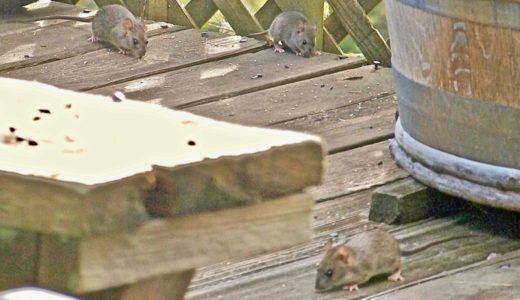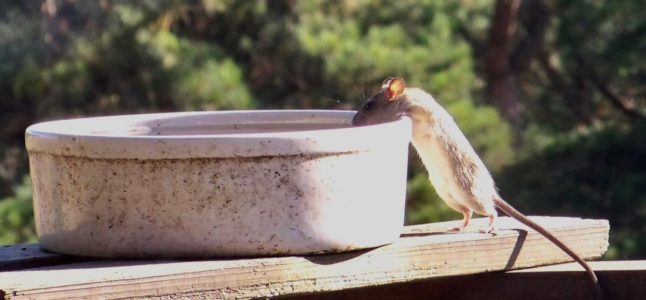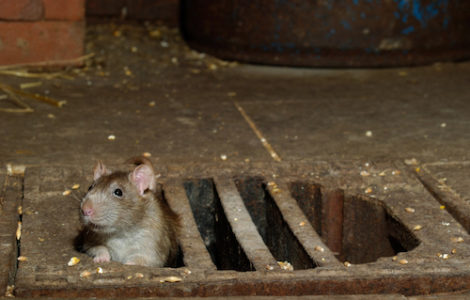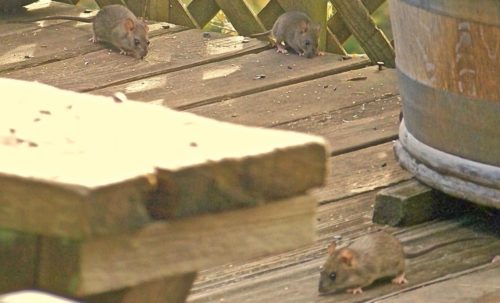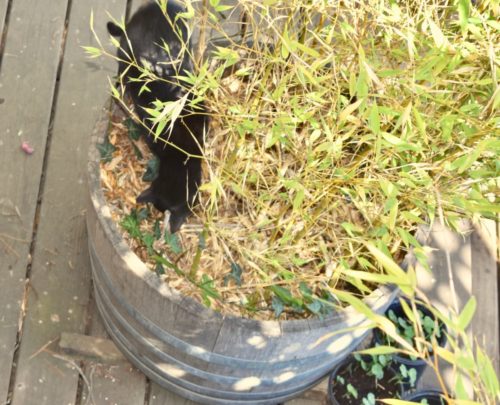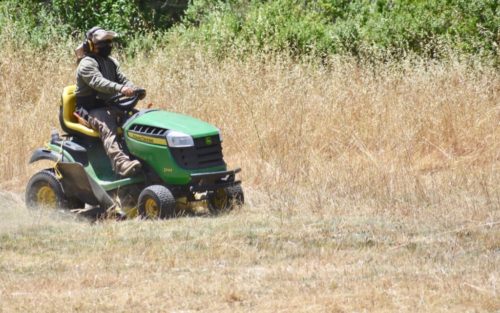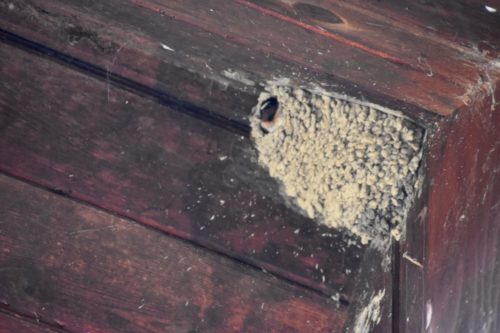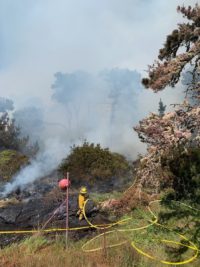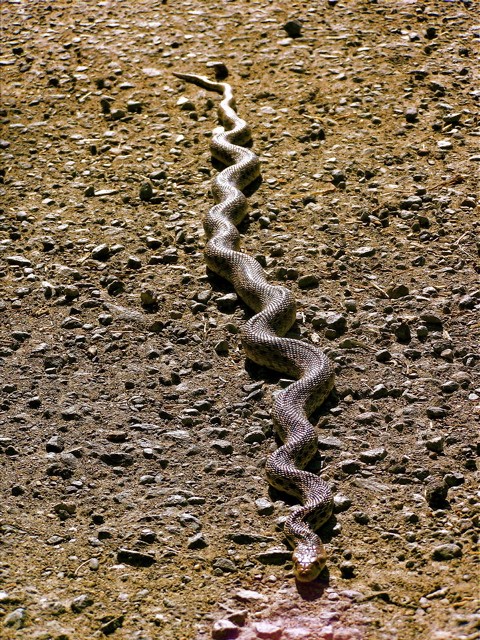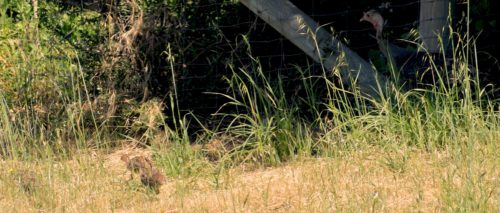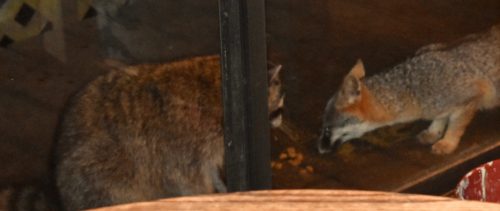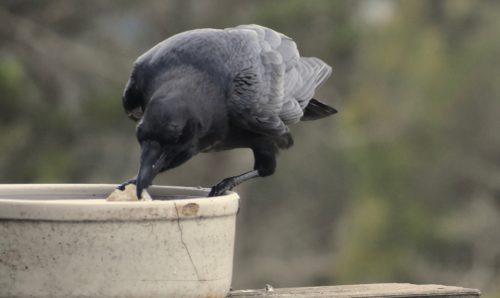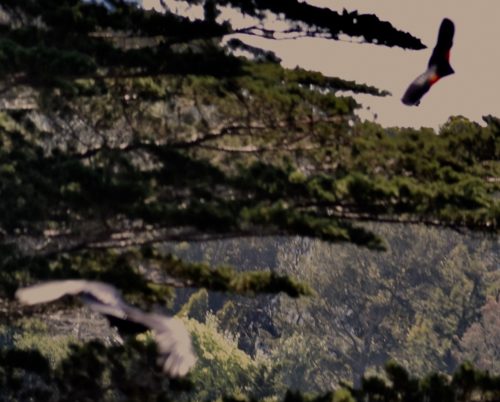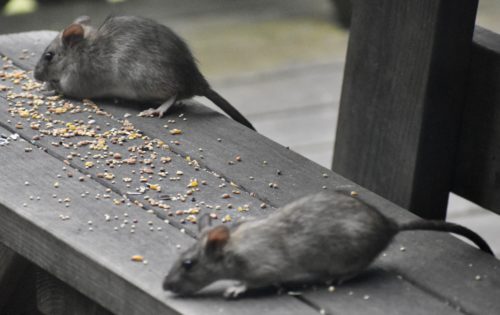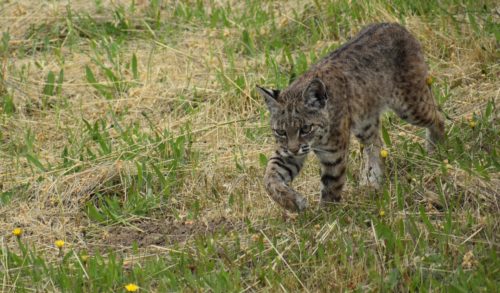Entries tagged with “roof rats”.
Did you find what you wanted?
Wed 15 Feb 2023
When readers submit comments, they are asked if they want to receive an email alert with a link to new postings on this blog. A number of people have said they do. Thank you. The link is created the moment a posting goes online. Readers who find their way here through that link can see an updated version by simply clicking on the headline above the posting.
For the second time in a row a posting is really late coming online. This time the problem was with Safari plus a myriad of troubles upgrading the operating system in my computer. My wife Lynn spent several hours on the phone for four days this past week, talking with computer techies to straighten it all out. This posting was actually written last week.
It’s been a week of surprising observations. I was downtown a week ago ago when I thought I spotted my wife Lynn’s parked car. I walked over to it and was about to open the passenger’s door when I realized the woman inside was not Lynn. Moreover, the woman had her skirt raised above her waist and was adjusting the crotch of her panties. When I subsequently told Lynn, who was parked nearby, what my mistake had revealed, she sarcastically quipped, “Well, at least your timing was good.”
________________________________________________________________________________________
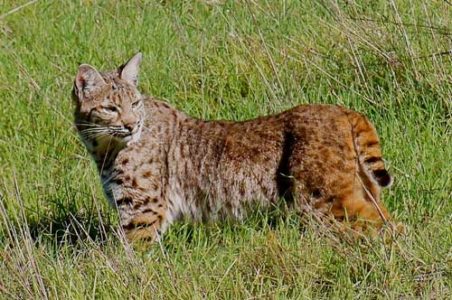
Lynn herself made a fascinating observation this week. She spotted a bobcat walking toward a doe in the field downhill from Mitchell cabin.
To Lynn’s surprise, the deer didn’t flee. Instead, the doe rose on her hind legs facing the bobcat and kicked at it with her front feet. The bobcat lumbered off.
We see several deer around Mitchell cabin every day, but bobcats only occasionally. This one, however, left a calling card: a small pile of scat by our front steps.

____________________________________________________________________________________
Lynn and I scatter birdseed morning and evening on our front deck’s railings and benches.

The birds enthusiastically consume most of the seed, but inevitably leave a bit behind.

Roof rats just as inevitably show up to finish off the leftovers. Here four rats gobble down what the birds left behind.

When rats show up before all the birds have left, the two manage to get along fairly well.
They’re called “roof rats” because the species likes to hang out near the tops of buildings. Our roof rats never get higher than the basement, and we’ve killed off those that got that far.
However, they also crawl inside Lynn’s car where they’ve gnawned through wiring and even gnawed their way into her glove compartment where they chew on road maps and other papers. In an effort to keeps them out of the car she sprays peppermint oil around their entry points. To some degree that helps, but it leaves the car smelling like a candy bar.
_______________________________________________________________________________
And now for some real humor, I’ll look to Jimmy Niro’s book Dad Jokes.
What did the cook say to the dough? I knead you.
I just finished my first day of excavation training. So far I’m really digging it.
You never see penguins in Great Britain because they’re afraid of Wales.
What did Tennessee? The same thing Arkansas.
Fri 14 Oct 2022
Posted by DavidMitchell under General News, Personal, West Marin nature, Wildlife
Comments Off on Birds, birdseed & roof rats, foxes & raccoons
The San Francisco Chronicle on Thursday carried a front-page story headlined, ‘Birdseed Lady to blame for rat swarms?’ The Chronicle reported a woman, who “appears to be experiencing mental illness,” daily leaves “mounds of birdseed throughout [the] commercial corridor” of the Glen Park neighborhood.
In doing so, she appears to be “fomenting the area’s formidable rat and pigeon problems.” As the article noted, city government still hasn’t figured out how to deal with her even though “city law forbids spreading birdseed in public places.”
The problem is more than esthetic. “The issue exploded into public view this month when health inspectors temporarily shuttered Canyon Market, Glen Park’s posh and popular grocery store, after finding gnawed pasta bags, rat droppings, and other evidence of a severe rodent infestation.”

I’ve seen the pattern on a small scale at Mitchell cabin. The birdseed Lynn and I put on our deck daily for our feathered neighbors also draws a handful of roof rats.
The birds such as this towhee act as if the roof rats were just other birds and are quite content to eat alongside them.
The birds also share their bath with the rats, who like to take sips from it.

So far the roof rats are not an insurmountable problem although they do nibble on flowers Lynn planted in our garden and — worse yet — on the wiring for her car’s engine.
The rats are amazingly predictable. We tend to put out seed around 5:30 p.m. daily, and the roof rats show up around 6:30 p.m.
————————
Among the other trends in wildlife around Mitchell cabin are changes in the fox community, which had mostly kept out of sight during the past couple of years. Foxes, nonetheless, made their presence known by frequently peeing on my morning Chronicle. It’s all about marking territory. Thank goodness subscriptions are delivered in plastic bags.

Last week I spotted two foxes together on our deck until they were scared off when two young raccoons got into a noisy tiff.
————————
A young man in town told me he wants to wear a pest-control uniform for Halloween. I told him to gopher it.
Have you ever wondered why cats eat fur balls. They do it because they love a good gag.
And why do bears have hairy coats? Fur protection, of course.
Tue 23 Aug 2022
 Once upon a time, I taught this possum proper table manners. 🙂
Once upon a time, I taught this possum proper table manners. 🙂
Getting him to eat with a knife and fork instead of his fingers was the biggest challenge.
More oddities. Last February, this blog reported: “The oddest West Marin news in the past fortnight came in the Feb. 3 Point Reyes Light. Here it is word for word. ‘Sheriff’s Call — Sunday, Jan.10: NICASIO: At 7:42 p.m. a woman who said she was moving to town from Southern California reported that someone who works at the post office was shooting metaphorical arrows, meaning witchcraft and sorcery, and that God had told her she needed to eradicate witchcraft and sorcery. She said the man was going to make her have demonic serpent offspring and she could not report him to his supervisor because the supervisor was likely in the same region of warlocks, and she wanted to assure deputies that she had not been struck by the arrows because she was protected by the blood of Jesus — she had an X-ray to prove it.'”
Postal sorcery seems to have now spread west. A sheriff’s call in the Aug. 11 Light reported: POINT REYES STATION: “A woman moving back to the area from Los Angeles said a former postal worker was tracking her with witchcraft and sending arrows to her head.” If it is the same woman, I hope the blood of Jesus is still protecting her.

Three roof rats scamper around our deck eating some of the seeds we’ve put out for wild birds. A professional gardener in town this week said the local roof-rat population “exploded” this year.

Roof rats take advantage of our bird ‘sanctuary’ in more than one way. Here a roof rat drinks from our birdbath. The roof rat’s pale underside helps distinguish it from brownish-gray Norway rats. Despite their name, Norway rats are believed to have originated in Asia and spread westward through Russia. Once in Europe, Norway rats in the 18th century were inadvertantly introduced worldwide when they hid on trading ships, often in the cargo.

Norway rats are sometimes referred to as sewer rats because they are often found in big city sewers. Here a sewer rat pokes its head out its front door. Norway rats can damage homes with their gnawing and can spread diseases. MPHonLine photo
Thu 10 Jun 2021
Posted by DavidMitchell under Uncategorized
Comments Off on Roof rats, swallows, and thistles
Caveat lectorem: When readers submit comments, they are asked if they want to receive an email alert with a link to new postings on this blog. A number of people have said they do. Thank you. The link is created the moment a posting goes online. Readers who find their way here through that link can see an updated version by simply clicking on the headline above the posting.
Roof rats are a fact of life throughout West Marin, causing extensive damage by chewing on stored belonging and particularly on the wiring of automobile engines. A couple of times over the years, Cheda’s Garage has repaired rat damage to my cars.

Roof rats on Mitchell cabin’s deck eating leftover seeds scattered for the birds.
Of recent, the rats have annoyed my wife Lynn by eating the buds off a potted camellia I had given her as a Valentine’s present several years ago. On Tuesday, Newy, the stray cat we’ve adopted, went digging in a wine-barrel half that holds a clump of bamboo. Immediately an adult rat jumped out of a second hole on the other side of the barrel and ran off.

Newy kept on digging and soon caught a baby rat. Here she leans into the barrel to inspect a rat hole before sticking her claws into the creatures at the bottom. She had already snared one newborn (at left) and ultimately caught a total of four.

The newborn roof rats were so young their eyes hadn’t yet opened. Nor had they grown fur coats. Nature red in tooth and claw reveals where Newy grabbed the first unlucky creature.
________________________

Jesus to the rescue. As noted here last week, the grass around Mitchell cabin needed to be cut ahead of the fire season. In addition, the fields were becoming dotted with clumps of prickly thistles. As I’ve done in previous years, I called Jesus Macias who showed up Monday with a riding mower and two weed-whacking helpers.
They did a great job but had to leave a small patch of grass near the kitchen uncut because of a swarm of bumblebees there. Luckily I was able to cover myself up so completely two days later that I managed to weed-whack that patch without getting stung. A small swarm did form, but I left before they went after me.
Reader Mike Gale, a Chileno Valley beef rancher, responded to last week’s reference to the Mother Goose rhyme’s timing for cutting thistles: “Cut thistles in May,/ They’ll grow in a day;/ Cut them in June,/ That is too soon;/ Cut them in July,/ Then they will die.”
As was noted, however, Mother Goose rhymes were originally penned 300 years ago in the more-northern latitudes of England and France, where the growing season starts later. Thistles in West Marin need to be cut a month earlier. “Yes, this is the time for the attack mode,” Mike wrote me. “Unfortunately thistles are probably the last species to be affected by the drought.”
_________________________

Still swallowing. Another item in the last posting concerned cliff swallows building a nest in the eves above our kitchen door. We’ve now seen at least two adult swallows in the mostly completed nest, prompting me to read a startling fact about cliff-swallow nesting.
“Individuals often lay eggs in other individuals’ nests within the same colony,” the US Fish and Wildlife Service reports. “It has been observed that some [of these] parasitic swallows have even tossed out their neighbors’ eggs and replaced them with their own offspring.”
Mon 10 Jun 2019
Caveat lectorem: When readers submit comments, they are asked if they want to receive an email alert with a link to new postings on this blog. A number of people have said they do. Thank you. The link is created the moment a posting goes online. Readers who find their way here through that link can see an updated version by simply clicking on the headline above the posting.
It’s a strange week. At 2 p.m. today the thermometer at Mitchell cabin reached 101 degrees. Just after 3 p.m. I received a recorded telephone alert from the Sheriff’s Office saying there was a vegetation fire in West Marin but that so far no evacuations had been ordered. That was pretty vague, so I checked the fire department’s website which said: “Units are responding to the Drake Fire, a fire along Inverness Road near Limantour. Currently, the fire is approximately two acres in size with a slow rate of spread. One structure threatened.”

Sheriff’s photo of the Drake Fire.
No one seemed to know where “Inverness Road” is, but around 4 p.m. the fire department posted that the fire was in the National Seashore, was near Vision Road (not Inverness Road), was 50 percent contained, and had been held to less than three acres.
My wife Lynn, who’s the Point Reyes Disaster Council coordinator, urges everyone to sign up for alertmarin.org and nixle.com. The sheriff, via Alertmarin, has your home phone number, but you need to register your cell phones. You can hear about such things when you’re over the hill. Nixle will reach you on smartphones; she automatically received messages that way today, while I received the home robocall. And, she says, check the Marin County Fire twitter feed (you don’t need a twitter account). If you have no internet devices, tune in to KWMR on the radio for current information.
The Drake Fire, which was started by a tree limb falling on a powerline, follows a small fire Sunday on Mount Tamalpais near Panoramic Highway and Muir Woods Road. A PG&E transformer has been blamed for that fire.

Meanwhile, the Sand Fire in Yolo County has burned 2,200 acres and as of Monday afternoon is only 30 percent contained. Smoke from that fire drifted over West Marin Sunday, and made Monday’s sunrise particularly dramatic. (Photo by Linda Sturdivant of Inverness Park)

Snake handling. As I started up our road Saturday, I spotted a three-foot-long gopher snake stretched out across the pavement sunning itself. Lest another car run over it, I stopped, got out, and grabbed the snake around its neck just behind its head. Holding the tail out with my other hand, I carried it uphill to a grassy area and released it. The snake quickly slithered off. It was the second time in the last year or so I carried a snake off the road. This time I didn’t get at all nervous.

Different species cohabiting at Mitchell cabin. A flock of wild turkeys casually walks past a doe and young buck, which hardly notice.

A wild turkey hen guides her chicks along the edge of the field.

Dinner mates eating kibble. A raccoon and gray fox dined nose to nose on our deck last night, and neither seemed to worry the other.

A raven moistens bread in our birdbath to make it easier to swallow. God only knows where he found the bread, but then he’s always coming up with biscuits, cookies, birds eggs, and animal parts. Last week Lynn and I watched this raven kill a gopher in the grass and then tear it apart.

Protecting its nest, a red-winged blackbird (top right) repeatedly buzzes and pecks the raven (lower left) as it flies away.
“The population of the common raven is exploding across the American West, where it thrives on human refuse and roadkill,” The Los Angeles Times reported Sunday. “As the large, strutting predators piggyback on the spread of human civilization, they are expanding into territories where they have never been seen in such large numbers. This expansion has come at the expense of several threatened species, including the desert tortoise, whose soft-shelled hatchlings and juveniles have been devoured by the birds.” Scientists are now trying to reduce the number of desert ravens by using drones to spray oil on their nests.

Two roof rats gobble up birdseed before the birds eat it all.
In addition to all that excitement, Lynn in the past week managed to photograph some of our more exotic wildlife:

An egret walking beside our driveway last Thursday.

One of our local bobcats a week ago heading toward our garden, which it traversed without disturbing any flowers.
Mon 6 Jan 2014
I’m using the start of the new year as an occasion to exhibit a number of wildlife photos I’ve shot around Mitchell cabin during the past three or four years. I make no pretense to having produced photographic masterpieces, for I still use a Kodak EasyShare, a primitive digital camera that’s no longer made.
Wild animals in unlikely juxtapositions, whether deliberate or serendipitous, are some of my favorite subjects, so let’s begin with a few.
Deer in particular are curious about other creatures that are not big enough to be threatening. Friendships such as that of Bambi and Thumper are not all that unusual in the real world. Indeed, I once saw a young deer trying to cozy up to a jackrabbit; the rabbit, however, retreated under a bush when the fawn got too close.
 Here a blacktail doe sticks around to watch Linda Petersen’s late Havanese named Sebastian when the dog wandered down my driveway.
Here a blacktail doe sticks around to watch Linda Petersen’s late Havanese named Sebastian when the dog wandered down my driveway.
__________________________________________________________________
 The blacktail around Mitchell cabin appear particularly interested in housecats.
The blacktail around Mitchell cabin appear particularly interested in housecats.
Here a nosy doe watches a cat on a woodpile cleaning its fur.
__________________________________________________________________
 Deer and housecats seem pretty much at ease around each other, somewhat in the same way that deer get along with cows and horses.
Deer and housecats seem pretty much at ease around each other, somewhat in the same way that deer get along with cows and horses.
________________________________________________________________

A bit more surprising, to me at least, was seeing this doe and great blue heron hunting together in my pasture. The deer was there to dine on new clumps of green grass while the heron was there to dine on gophers. ________________________________________________________________

Some creatures, however, need encouragement to fraternize. Foxes and raccoons aren’t terribly fond of each other, but they will show up to the same feast, which in this case consisted of honey-roasted peanuts I’d scattered on the deck. __________________________________________________________________

Possums and raccoons are even less companionable under normal circumstances. If a raccoon gets too close, a possum will often bare its fangs although it’s all a bluff. But both critters will peaceably attend ecumenical dinners when honey-roasted peanuts are served. _________________________________________________________________

Possums, in fact, can be convinced to undertake almost any endeavor if the reward is honey-roasted peanuts. In one notable case, I was able to use sweet-roasted goobers to teach a possum table manners. __________________________________________________________________

One of the most popular photos I ever posted involved my using the same peanuts to encourage a bodhisattva possum along his path to enlightenment. Word of the photograph must have gotten around. For months after I posted it, one of the more-frequently Googled terms bringing people to this blog was “bodhisattvva possum.” __________________________________________________________________

Turning now to birdbaths. A towhee keeps its feathers in good condition by washing in the birdbath on the deck of Mitchell cabin. Such ablutions are why we call the these basins birdbaths. _________________________________________________________________

And, of course, many birds count on birdbaths for their source of drinking water. Here a mourning dove leaves the birdseed to a towhee for a moment while it takes several gulps. Because so much of their food is dry, these birds need regular drinks to wash it down. I place a couple of bricks in the birdbath for birds that like to stand in water. ___________________________________________________________________

Birds are not the only creatures who use the basin for bathing and as a source of drinking water. I’ve seen as many as four raccoons squeeze into the birdbath to wash their paws after eating. Here three kits balance effortlessly 15 feet above the ground on the narrow railing of my deck as they clamber in and out of the basin at night. ______________________________________________________________________

Nor do I discriminate. My birdbath also provides drinking water for any creature that can get to it. Honeybees frequently show up to drink although a few inevitably fall in.
Probably the drinkers with the worst reputation are the roof rats. These rats originated in southern Asia, and you’ll recall it was their fleas that spread the Black Death throughout Europe in the 14th Century, killing roughly half the people.
I don’t mind roof rats’ drinking from the birdbath and stealing birdseed from my deck, but I’ve periodically had to trap rats that got into my basement. The problem is their unfortunate habit of gnawing on everything chewable from paper to dishwasher drain hoses to electrical-wire insulation.
It’s really too bad they’re such nuisances because, as you can see, they’re awfully cute.
Sat 18 Aug 2012
Posted by DavidMitchell under Marin County, West Marin nature, Wildlife
Comments Off on Not quite what you’d expect
“The absurd is the essential concept and the first truth,” wrote the French existentialist Albert Camus. As an existentialist myself, I’ve long believed that if this were a rationally ordered world, it would be much different.
This is true not only in the human world but in the animal world as well. The results can be good or bad or just ridiculous. Let’s take a look.

Although roof rats sometimes eat birds’ eggs, they can, counter-intuitively, get along with adult birds. Here a scrub jay and a roof rat eat birdseed side by side on my picnic table.

The small, beady eyes of roof rats may make them look malicious, but this little junco feels safe enough to keep on pecking only inches away from one.

In fact, adult birds, such as this towhee, and roof rats are almost indifferent to each other when they both happen upon the same birdseed buffet.

The rats and birds not only share the same scatterings of seeds, they drink from the same birdbath. Because animals have no sense of absurdity, these arrangements no doubt seem perfectly natural to them.
Harder to understand are everyday absurdities in the human world.

Is it: ‘Speed up or be cited’? Or: ‘Slow down or be cited’?
This ambiguous road sign is beside Highway 1 a mile and a half north of Tomales Bay Oyster Company in Marshall. In recent years, signs announcing the ending of various speed limits have been sprouting up along the state highway and county roads in West Marin. Unfortunately, they don’t always say what speed limit is beginning.

It makes sense that the 55 mph limit along the Point Reyes-Petaluma Road ends here at Platform Bridge. As the word STOP painted on the pavement makes clear, motorists are approaching a stop sign.
The question is: what’s the speed limit on the other side of the stop sign?

To stay on the Point Reyes-Petaluma Road, westbound motorists after stopping turn right and cross Platform Bridge; in slightly over a tenth of a mile, they eventually come to a 50 mph speed-limit sign. But what if they continue straight on Platform Bridge Road? They find no speed-limit signs whatsoever. Are unstated speed limits “radar enforced”?

In contrast to the paucity of speed-limit information at Platform Bridge, there’s an over abundance of it a couple of miles east at Four Corners. (Four Corners is the T-intersection where Nicasio Valley Road ends at the Point Reyes-Petaluma Road. A ranch road provides the third and fourth corners.)
Most of us would assume that one, if not two, of the three speed-limit signs above is superfluous, especially when they’re all so close together. The excess is basically a distraction from the deer-crossing sign.
Which gets me back to my original assertion: if this were a rationally ordered world, it would be much different.
Mon 6 Feb 2012
 Last week I reported that a Guatemalan wife and mother of two, Cristina Siekavizza (at right), disappeared July 7.
Last week I reported that a Guatemalan wife and mother of two, Cristina Siekavizza (at right), disappeared July 7.
Authorities suspect she was murdered by her husband, Roberto Barreda de Leon, and that he has probably fled to the United States, taking the couple’s two children, Roberto Jose, 7, and Maria Mercedes, 4, with him.
As I wrote, I became interested in the case because my former wife Ana Carolina Monterroso is a friend of Cristina’s relatives. She and Cristina’s brother Pablo have notified me that roughly 25,000 people are currently using social media to track down Roberto.
I believe it. Last week’s posting drew a record 1,217 visitors in the first three days after it went online. Some 432 of those were in Guatemala. Readers have posted links to this blog on their Facebook pages and on other websites. Truly social media in action.

An international warrant for the English-speaking husband’s arrest has been issued. If people spot him, they should notify local law enforcement or the FBI. Please note that the email address in Guatemala for reporting his whereabouts is incorrect on the wanted poster. It should be busquedacristina@gmail.com.
 Point Reyes Station. Mitchell cabin with its red roof is near the center of the photo.
Point Reyes Station. Mitchell cabin with its red roof is near the center of the photo.

Around Mitchell cabin two foxes are making themselves more and more at home with every passing week. Lynn and I can hand feed them slices of bread although one is more skittish than the other. The first sits around the kitchen door waiting for me to hand it dinner. Usually we have to throw the slices to its partner.
 For a year or more we had been feeding our foxes and raccoons honey-roasted peanuts along with bread, but that became fairly expensive.
For a year or more we had been feeding our foxes and raccoons honey-roasted peanuts along with bread, but that became fairly expensive.
Our problem was solved by Gayanne Enquist of Inverness.
She recommended we forget about peanuts and feed our critters dog kibble. It was a brilliant idea.
Once we determined through experimentation which brand they prefer, Kibble and Bits, we could eliminate peanuts and most bread from their dinners.
However, the kibble is so popular that we might as well be feeding two large dogs.
Along with the foxes, we get five or six raccoons every night.
One raccoon is a solitary male. The others belong to two families that don’t like each other, so we have to put out two trays of kibble on the deck and keep refilling them.
That adds up to about 40 pounds of kibble per week.
The foxes wait their turn for the kibble until the raccoons leave although the raccoons are also a bit wary of the foxes.

Of course, we’re not always Johnny on the spot in setting out their dinners, and here a fox waits patiently while a raccoon approaches cautiously.

We also feed a variety of birds, including towhees, sparrows, doves, and scores of redwing blackbirds. They have a set feeding time, somewhere between 4:30 and 5 p.m. However, the birds aren’t the only beneficiaries of the birdseed. Roof rats, those cute little rodents, show up almost as soon as the blackbirds leave.

Blacktail deer are ubiquitous around Mitchell cabin. This year I’ve seen as many as 14 at one time. Here a fawn sleeps right outside our kitchen window while two does graze nearby.
The deer are so comfortable around us that I can often approach them within a few feet.
Although we’re in the middle of winter, these are great days to relax. Just keep your eyes out for a murder suspect fleeing Guatemala.
Tue 2 Aug 2011
In researching his 2008 book Vital Diversities: Balancing The Protection of Nature and Culture, Inverness writer Mark Dowie later recounted in the West Marin Review, “A Yupik native scientist [in Alaska] told me, ‘We have no word for ‘wilderness.’ What you call wilderness, we call our backyard.'”
 This mother raccoon brought her three kits to my deck for the first time a week ago.
This mother raccoon brought her three kits to my deck for the first time a week ago.
The Yurik concept of wilderness makes perfect sense to me. My backyard, even my deck, could easily be called “wilderness.”
 My wilderness includes deer in my fields on a daily basis. On rare occasions I’ve seen coyotes, bobcats, and badgers, and every night a group of smaller animals shows up on my deck.
My wilderness includes deer in my fields on a daily basis. On rare occasions I’ve seen coyotes, bobcats, and badgers, and every night a group of smaller animals shows up on my deck.
The critters at night are usually foxes, raccoons, and possums looking for bread or peanuts.
It’s often easy to hear the call of the wild in my backyard. Some alpha males, especially among red-winged blackbirds and raccoons, seem more intent on driving other males away from food than with getting some for themselves.
The second time the three kits showed up (right), their mother was not with them.
Before long, an adult raccoon began growling at them, and they took refuge in a narrow gap between my woodbox and the wall of my cabin. When the adult stuck around, they were too frightened to leave, so I finally went outside. This caused the adult to run off a short distance and provided the kits with a chance to escape.
After all, someone has to keep order on my deck, and it’s fallen to me to enforce the law of the wild.

The foxes get along with each other better than the raccoons do, and because they’re not intra-species rivals, the raccoons will often eat side by side with foxes when I put out peanuts. I’ve even had a possum join in, creating an ecumenical dinner for local wildlife.
Red-winged blackbirds look over my deck prior to landing on it.
Every day in the late afternoon I put out birdseed, which attracts pigeons, doves, quail and juncos, but most of all it brings in bluejays, towhees and red-winged blackbirds.
 The birdseed also attracts roof rats. These cute little critters with long tails are amazingly good at climbing walls and railings, jumping onto the picnic table, and squeezing through tiny openings.
The birdseed also attracts roof rats. These cute little critters with long tails are amazingly good at climbing walls and railings, jumping onto the picnic table, and squeezing through tiny openings.

A fortnight ago, Linda Petersen of Inverness, ad manager of The West Marin Citizen, took a week’s vacation and left her Havanese dog Eli in the care of my girlfriend Lynn and me.
Late one afternoon, he, Lynn and I were sitting on my deck at sunset when Eli spotted one of the roof rats, which spotted Eli at the same time. I grow flowers on my deck in wine-barrel halves, and the rat scurried under one of the barrels. Immediately Eli was sniffing under the barrels, barking and growling.
It was pandemonium. While Eli would try to drive a rat out from under one barrel, another rat would pop out from under a nearby barrel and dash across my deck to safety. Before he was done, Eli had flushed seven roof rats. It was an exciting drama, but it made me glad that, at least for the moment, I’ve been able to seal off my basement against the rats. For now, they show up only when the birdseed is first scattered.

Quietly watching the drama but staying out of it was this Western fence lizard on my wall. It moved very little, depending on its coloring for camouflage. Fence lizards, I should note, are often dark when they first get up in the morning and become lighter as the day grows warmer. Kind of like the rest of us.
Mon 11 Oct 2010
The most recent wildlife adventures around my cabin began three weeks ago when I started down my driveway to pick up the morning Chronicle. There in the dirt at the edge of my parking area were several large paw prints, too large for the critters I usually see around here. Roughly 25 feet away, other tracks showed where a deer had kicked up dirt as it ran off.
A check of my tracking guide confirmed a mountain lion had probably been on my property the night before. That was an exciting but not altogether surprising discovery, for I’ve heard reports of mountain lion sightings along Tomasini Canyon Road, the next road to the north.

A gray fox eating bread on my deck.
With so much wildlife on this hill, my cabin has become a sort of blind for observing it.

In the past week, up to three foxes at a time have shown up on my deck. I sometimes feed them a few pieces of bread or a few peanuts, but judging from their scat, with which they mark my property (including the roof of my car), their main diet these days is blackberries.

On several occasions, I’ve watched encounters on my deck between raccoons and a fox. Neither seemed overly alarmed by the other, and at times the fox approached a raccoon within a few feet.
This is not to say that no other wildlife alarms raccoons. One kit sprang onto a post of the deck railing tonight and was about to climb to the top when suddenly it froze and flattened itself against the lattice.
For half a minute it hung there with only its head peeking over the top. Eventually the kit climbed on top of the railing, paced back and forth, but went nowhere. About this time, a couple of deer walked by just beyond the railing. Only when they were gone did the kit feel free to resume its meandering.

The foxes, however, seem not to be alarmed by any creature around my cabin. Sunday night when I scattered some tortilla chips on the deck and left the door open, this fox was curious enough about my kitchen to look inside before chowing down on the chips.

The foxes are usually skittish enough to run off a few feet when I open the kitchen door, but they quickly return.
And twice when my friend Lynn Axelrod stuck a piece of bread out the door, a fox took it from her hand.

Three, four, and even five raccoons have shown up simultaneously on my deck in the last week. They too enjoy snacking on bread, but except for one older male, they enjoy peanuts even more.
I occasionally put out a few handfuls of honey-roasted peanuts for their dessert, and I’ve had raccoon kits so enthusiastic that on occasion they grabbed my hand with their paws before I was done. Very odd to shake hands with a raccoon. Thank God they grabbed with their paws and not their teeth.
Because raccoons use their paws in eating, they wash them in my birdbath afterward, as well as take long drinks, no doubt thirsty from the salty peanuts.

Also taking advantage of my birdbath is this pine siskin.

A pine siskin swoops down to join five other siskins eating birdseed on the railing of my deck.
Pine siskins are an irruptive species, meaning that their populations can increase rapidly and irregularly. A type of finch, they are particularly plentiful this year because their main source of food, seeds, is also plentiful.
Also enjoying birdseed on my deck are roof rats, which on some evenings show up even before the birds leave.
There are noticeable variations in coloring among roof rats, with the one on the right demonstrating why they’re sometimes called black rats. I’ve written quite a bit about roof rats previously, and I won’t repeat it all here.

Canada geese fly over my cabin almost every evening. I always know by their honking when they’re coming. Some evenings several flocks in a row will head west overhead. Naturally a migratory bird, the geese used to only winter here, but in recent years West Marin has developed a large year-round population.
Also announcing themselves around my cabin these nights (in fact, I hear their yips and howls right now) are a number of coyotes. Like the gray foxes, coyotes are members of the dog family, canidae. However, unlike gray foxes, they can’t climb trees, which is a blessing for us all.


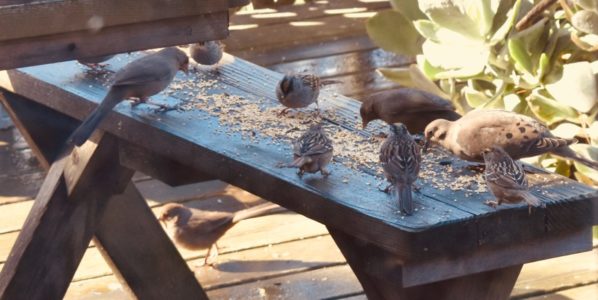
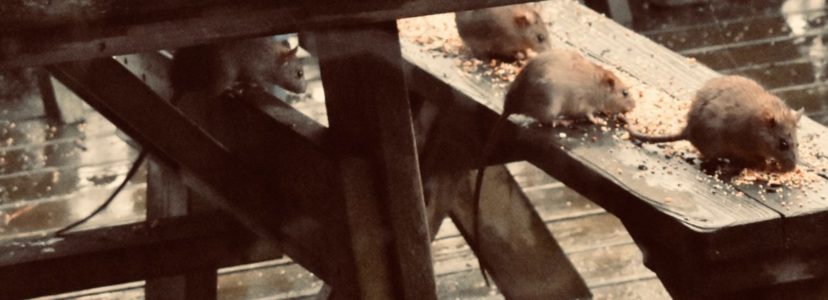
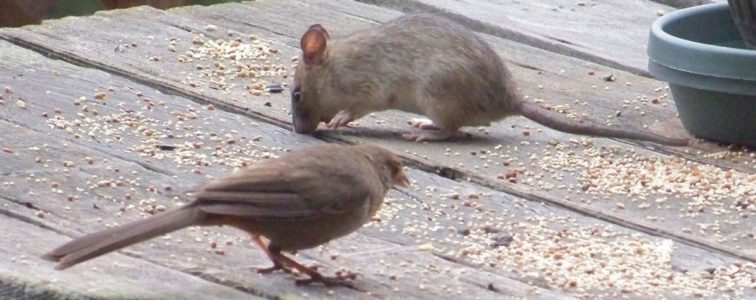


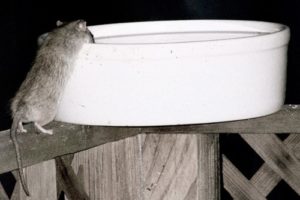
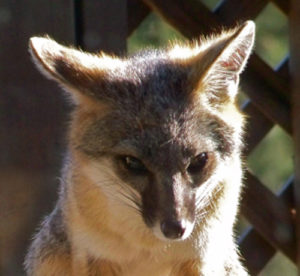
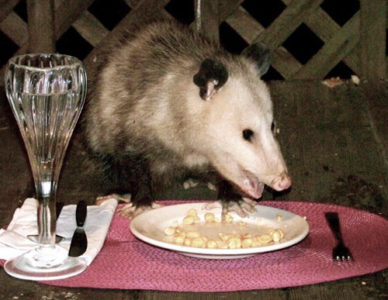 Once upon a time, I taught this possum proper table manners. 🙂
Once upon a time, I taught this possum proper table manners. 🙂